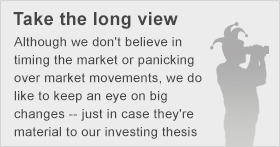Today, in contrast to the past couple of days, investors had an absolute smorgasbord of economic data dropped in their laps; and the initial reaction is that they were none too impressed, with the S&P 500 (^GSPC +0.62%) suffering its worst single-day loss in weeks.

It appears as if retail sales turned out to be the biggest culprit, with May's sales rising 0.3%, handily missing the bar that economists had set for a 0.6% improvement. Following the conclusion of the polar vortex, retail sales surged, but the euphoria failed to carry over into May. Weaker retail sales may signal that the consumer is becoming cash-strapped, which would be bad sign for U.S. GDP growth prospects.
In addition to retail sales data, weekly initial jobless claims also jogged in the wrong direction, heading higher by slightly more than 1% to a seasonally adjusted 317,000. Although this figure is still historically low compared to where we've been in recent years, investors would prefer to never see jobless claims rise, as it could mean that finding a job is getting tougher for the unemployed.
By day's end, the S&P 500 had swooned 13.78 points (-0.71%), to close at 1,930.11, its lowest close in more than a week. Despite the overwhelming negativity, three individual stocks led investors to some hefty gains today.
Topping that list was clinical-stage biopharmaceutical company Geron (GERN +0.00%), which advanced 21.2% after announcing that the Food and Drug Administration had removed its partial clinical hold on the investigator-sponsored trial involving imetelstat as a treatment for myelofibrosis. The FDA had placed a partial hold on this study in March, following liver toxicity abnormalities; but after receiving additional data from the Mayo Clinic's lead investigator from its IST, the FDA is now allowing it to continue. I find the partial-hold lift unsurprising given that imetelstat did deliver impressive response results in its myelofibrosis IST, but I'd also caution that the full clinical holds on its multiple myeloma and polycythemia vera indications are still in place. With absolutely no depth to its pipeline, there's still far too much risk built up in Geron, even at its greatly reduced share price.
Following closely behind Geron is home-furnishings retailer Restoration Hardware (RH +6.59%), which surged 12.7% after it reported its first-quarter results and raised its full-year outlook.

Source: Max Touhey, Flickr.
For the quarter, net revenue jumped 22%, to $366.3 million, as comparable-brand sales skyrocketed 18%. Furthermore, adjusted EPS tripled to $0.18 from $0.06 in the year-ago period. By comparison, Wall Street was only expecting Restoration Hardware to net $0.11 per share in profit on $346.8 million in sales. Furthermore, Restoration Hardware now sees revenue of $1.86 billion-$1.89 billion, and EPS of $2.24-$2.30 for the full year, up from its prior EPS forecast of $2.14-$2.22. While great news for shareholders, I'm a bit concerned that, at a forward P/E of 30, Restoration's products are a bit too "faddish" to have long-term staying power. I would strongly suggest waiting for a significant pullback before even considering this as a viable investment opportunity.

Source: Umberto Salvagnin, Flickr.
Lastly, shares of biopharmaceutical company ImmunoGen (IMGN +0.00%) tacked on 8.8% after research firm UBS upgraded it from sell to neutral, and set a price target of $13 on shares, implying 7% upside based on yesterday's closing price. According to UBS' analysis, a more optimistic outlook on Kadcyla sales and royalty revenue should help buoy ImmunoGen's share price. While I often advise ignoring analyst actions as they are short-term price movers and rarely have any bearing on our investing thesis, this is an upgrade I'd agree with. ImmunoGen has a very deep clinical-stage pipeline complete with a handful of major partnerships. With multiple opportunities to hit a home run, I believe ImmunoGen has all the tools necessary to succeed over the long run.








